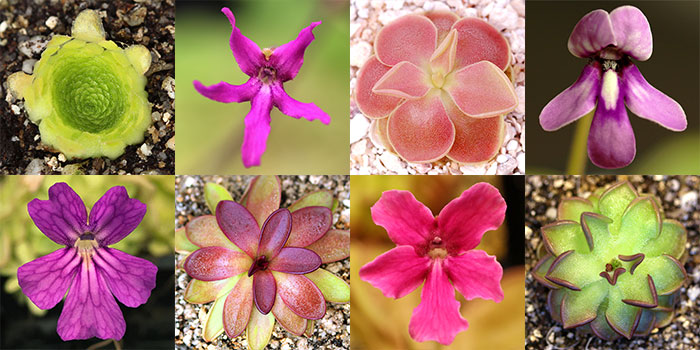To give your new carnivorous plant the best possible care and help minimize transplant shock, please follow the steps below. If you need more information after reviewing, please contact us or post in the comments, thank you!
1 |
Pot your plant using the appropriate soil (if bare root) |
For sundews, flytraps, pitcher plants, bladderworts, and bromeliads:
For tropical and Mexican butterworts:
2 |
Help your plant adjust to its new environment |
Read our guide on Carnivorous Plant Acclimation
3 |
Review your plant’s growing requirements |
Growing requirements are located on the corresponding curiousplant.com product page. These are the ideal conditions to aim for after acclimation.
4 |
Additional information and care guides |
-
Tropical and Mexican butterwort Care Guides
-
Feeding carnivorous plants: What to feed | How to feed
-
Light for carnivorous plants: Part 1 | Part 2 | Part 3
-
Watering carnivorous plants
-
Additional resources: books, forums, and online information





I just got my plants super excited but unfortunately they came in a night when I have to go to work…I can’t plant them tonight…what can I do to make sure they survive until the morning…?
Hi Lorry, thank you for your order! We did not get to your message until this morning so hopefully you found a solution, but having the plants sit in the containers they came in for one night is ok.
I ended up having time to plant them quickly, but now I’ll know for next time, thank you so much!!
I live in ohio zone 6 how do I keep the roots from freezing in the pots outside
Hi Lee, typically the plants will either need to be heavily mulched to provide insulation or kept in a sheltered location such as a unheated garage to prevent freezing.
I just got a very pretty butterwort. My question is, how often should I water her? I’ve had her for a week and have been giving a little water every other day. I’ve asked around and researched, but the information is vague. I can’t tell is she has enough moisture because her substrate is the sand/ perlite mix I got from you. I just want to make sure I don’t dehydrate her.
Hi Kallye, thank you for your order! For butterworts in their carnivorous phase, it is good to keep the media consistently damp. We have a video on watering butterworts in our care guides (link below) that offers some information about frequency and techniques as well. https://curiousplant.com/butterwort-care/
Thank you again!
Just got my bare root ‘Seductora’ and I’m in love all over again! Fine specimens indeed! Thank you so much!
Thank you so much Arturo!
Hello! I am so excited to write that I just received my new carnivorous babies!!! I was shocked that I received an email the same day that I ordered them, letting me know that they had shipped and I was shocked a second time when I received them a day and a half later. But the absolute real shocker was when I opened the the package to find all the plants to be even bigger than expected, especially the Big Pink Drosera carpensis! Originally I was going to plant the Big Pink, the Albino and the Drosera Aliciae together in one pot but had to rethink the planting since the plants were all so big. Thank you very much for such wonderful specimens, the QR code with the explanation on how to plant and acclimate these beauties and the nursery certificate stating that the plants were pest free. This is my first time ordering with your company and I wanted you to know that y’all hit it out of the ballpark on all levels. Thank you for your excellence!
Hi Lilia,
We’re so glad to hear the plants arrived safely and you are happy with your first experience ordering from us! Thank you so much for your support and wonderful feedback, it is certainly appreciated! We hope you enjoy growing the plants and they catch lots of bugs for you :)
Thank you again!
– Elizabeth & Kurtis
Hello! I recently got two carnivorous plants (a Venus flytrap that I’m not sure of the species, and what I believe is an Atala hybrid pitcher plant) as gifts and need help!
As for the pitcher plant, I’m not quite sure how to feed mine as the pitchers are closed. I’m not sure if it’s dormant, sick, or damaged from being taken home in the car from a gardening store downtown two or three days ago! Do you have any idea why?
My mom caught an insect for the Venus flytrap (though she’s not sure what it is) and placed it on one of its leaves. The bug is still alive and on the trap as I’m typing, and the trap still hasn’t closed around it. One thing I’ve noticed is that the traps are fully green, no red on the inside. Would that be an indicator of why it won’t respond? And now that I look closer at the trap with the insect on it, I can’t see any cilia on it, while another trap next to it has some. Is this normal? Am I just missing them?
Sorry for all the questions! My family and I are remarkably skilled at killing plants, and I’ve always wanted a carnivorous plant. Now I have two and I want to make sure they get the care they need!
Hi Kahlo,
Congrats on your new carnivorous plants! It sounds like the pitchers on your pitcher plant are fairly new and should open in a few days. Sometimes flytraps won’t close if they are stressed from poor growing conditions or if the traps are at the end of their life. It would be best to do some research on how to care for them to ensure their needs will be met. If you would like to learn more about feeding, we have an article here that may be helpful to you: https://curiousplant.com/how-to-feed-carnivorous-plants/.
I just received my Pinguicula ‘Florian’ bare root plant and I have several questions. (1) when do I start feeding it? (2) what brand and kind of fish food do you recommend? (3) when is the dormancy period and how long does last? If it’s now, how do I care for it since it’s a baby plant? Thank you!
Hi Victoria, I’m glad the plant arrived safely! You can begin feeding it when the dew returns on the leaves. TetraFin brand fish flakes work well, you can find more info and links for feeding here: https://curiousplant.com/what-to-feed-carnivorous-plants/. Dormancy usually begins around mid to late fall so it should be transitioning shortly but sometimes it can be delayed. Once it begins to go dormant you will want to water it less and only feed the plant if there is dew on the leaves. Dormancy usually ends in spring.
Word edit: specifically (not specially)
How do I provide the differing amounts of humidity to my D. Capensis ‘typical’ now that I just planted the bare roots and as I transition it to the appropriate light conditions? And how can I approximate the percentages of humidity without buying a gauge? I have one little tiny plant. :-)
Curt
Hi Curt, a common way to provide controlled humidity is to put the plant (pot and all) in a large freezer bag and seal it shut (100% humidity). Exact percentages aren’t necessary while making the transition, but you can use the numbers to estimate how much to open the bag each day (i.e. open the bag 5% of the way to reduce the humidity only slightly, 10% open to reduce it a little more, etc). Once the bag is fully open, you should be able to remove the pot completely and grow the plant in regular conditions. I hope this helps and thank you for your question!
Elizabeth
Thank you! One more question, how quickly does it grow and what will its initial growth look like ? More specially how will I know that I am taking care of it properly (it’s my first carnivorous plant)
You’re welcome Victoria! The growth rate will vary depending on the time of year, environmental conditions, and amount of food available. All new growth will appear in the form of new leaves emerging from the center of the plant. It would be best to refer to the care requirements on the product page to ensure you are meeting the plants needs, you can also refer to our resources page for additional information: https://curiousplant.com/carnivorous-plant-information-resources/.